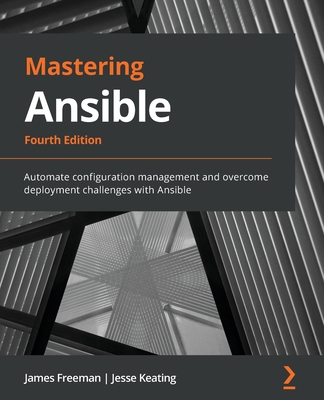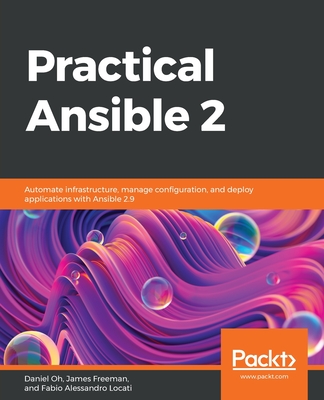Practical Network Automation: A beginner's guide to automating and optimizing networks using Python, Ansible, and more, 2/e
暫譯: 實用網路自動化:使用 Python、Ansible 等工具自動化與優化網路的初學者指南,第2版
Abhishek Ratan
- 出版商: Packt Publishing
- 出版日期: 2018-12-26
- 售價: $1,840
- 貴賓價: 9.5 折 $1,748
- 語言: 英文
- 頁數: 226
- 裝訂: Paperback
- ISBN: 1789955653
- ISBN-13: 9781789955651
-
相關分類:
Ansible、Python、程式語言
海外代購書籍(需單獨結帳)
商品描述
Leverage the power of Python, Ansible and other network automation tools to make your network robust and more secure
Key Features
- Get introduced to the concept of network automation with relevant use cases
- Apply Continuous Integration and DevOps to improve your network performance
- Implement effective automation using tools such as Python, Ansible, and more
Book Description
Network automation is the use of IT controls to supervise and carry out everyday network management functions. It plays a key role in network virtualization technologies and network functions.
The book starts by providing an introduction to network automation, and its applications, which include integrating DevOps tools to automate the network efficiently. It then guides you through different network automation tasks and covers various data digging and performing tasks such as ensuring golden state configurations using templates, interface parsing. This book also focuses on Intelligent Operations using Artificial Intelligence and troubleshooting using chatbots and voice commands. The book then moves on to the use of Python and the management of SSH keys for machine-to-machine (M2M) communication, all followed by practical use cases. The book also covers the importance of Ansible for network automation, including best practices in automation; ways to test automated networks using tools such as Puppet, SaltStack, and Chef; and other important techniques.
Through practical use-cases and examples, this book will acquaint you with the various aspects of network automation. It will give you the solid foundation you need to automate your own network without any hassle.
What you will learn
- Get started with the fundamental concepts of network automation
- Perform intelligent data mining and remediation based on triggers
- Understand how AIOps works in operations
- Trigger automation through data factors
- Improve your data center's robustness and security through data digging
- Get access infrastructure through API Framework for chatbot and voice interactive troubleshootings
- Set up communication with SSH-based devices using Netmiko
Who this book is for
If you are a network engineer or a DevOps professional looking for an extensive guide to help you automate and manage your network efficiently, then this book is for you. No prior experience with network automation is required to get started, however you will need some exposure to Python programming to get the most out of this book.
Table of Contents
- Fundamental Concepts of Network Automation
- Python Automation for Network Engineers
- Ansible and Network Templatizations
- Using Artificial Intelligence in Operations
- Web Framework for Automation triggers
- Continual Integration
商品描述(中文翻譯)
利用 Python、Ansible 及其他網路自動化工具的力量,使您的網路更加穩健和安全
主要特點
- 介紹網路自動化的概念及相關的使用案例
- 應用持續整合和 DevOps 來改善您的網路性能
- 使用 Python、Ansible 等工具實施有效的自動化
書籍描述
網路自動化是利用 IT 控制來監督和執行日常網路管理功能。它在網路虛擬化技術和網路功能中扮演著關鍵角色。
本書首先介紹網路自動化及其應用,包括整合 DevOps 工具以有效地自動化網路。接著,指導您完成不同的網路自動化任務,涵蓋各種數據挖掘和執行任務,例如使用模板確保金狀態配置、介面解析。本書還專注於使用人工智慧進行智能操作,以及利用聊天機器人和語音命令進行故障排除。然後,本書將介紹 Python 的使用及 SSH 金鑰的管理,以實現機器對機器 (M2M) 通信,並附上實際使用案例。本書還涵蓋 Ansible 在網路自動化中的重要性,包括自動化的最佳實踐;使用 Puppet、SaltStack 和 Chef 等工具測試自動化網路的方法;以及其他重要技術。
通過實際的使用案例和範例,本書將使您熟悉網路自動化的各個方面。它將為您提供自動化自己網路所需的堅實基礎,讓您無需煩惱。
您將學到什麼
- 開始了解網路自動化的基本概念
- 根據觸發條件執行智能數據挖掘和修復
- 了解 AIOps 在運營中的運作方式
- 通過數據因素觸發自動化
- 通過數據挖掘提高數據中心的穩健性和安全性
- 通過 API 框架獲取基礎設施,以進行聊天機器人和語音互動故障排除
- 使用 Netmiko 與基於 SSH 的設備建立通信
本書適合誰
如果您是網路工程師或 DevOps 專業人士,尋找一本全面的指南來幫助您有效地自動化和管理網路,那麼本書適合您。開始時不需要具備網路自動化的經驗,但您需要對 Python 編程有一定的了解,以便充分利用本書。
目錄
- 網路自動化的基本概念
- 網路工程師的 Python 自動化
- Ansible 和網路模板化
- 在運營中使用人工智慧
- 自動化觸發的網頁框架
- 持續整合






















